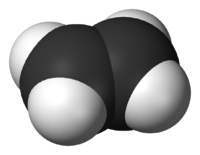
Photo from wikipedia
Summary The first C–C bond formation mechanism in the methanol-to-hydrocarbons (MTH) process has always been a highly controversial issue. Using solid-state NMR spectroscopy, the initial C1 reactants and C1 intermediates… Click to show full abstract
Summary The first C–C bond formation mechanism in the methanol-to-hydrocarbons (MTH) process has always been a highly controversial issue. Using solid-state NMR spectroscopy, the initial C1 reactants and C1 intermediates were observed on the HSSZ-13 zeolite surface. In particular, for the first time, the highly reactive ethene precursor, surface ethoxy species, was directly captured under a real MTH reaction. These findings and in situ captured activated C1 reactants linked C1 species and initially generated ethene, in which C1 intermediates activate methanol/DME to form the first C–C bond. For such a difficult-to-detect and extremely initial reaction process, the advanced ab initio molecular dynamics technology simulated the complete process from C1 reactants to product. The visualized reaction process vividly shows methanol/DME in the gas phase approaching SMS/TMO on zeolite, being activated via effective collision and methylation to generate an ethene precursor. The zeolite catalyst and active C1 intermediates contribute together to the first C–C bond formation in a synergistic manner.
Journal Title: Chem
Year Published: 2021
Link to full text (if available)
Share on Social Media: Sign Up to like & get
recommendations!